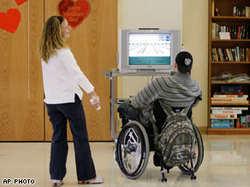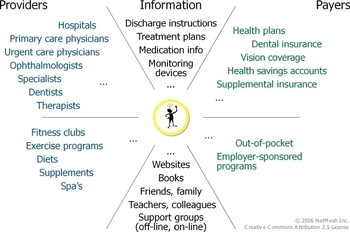 I’m still conflicted about this whole Wii-physical therapy link. One side of me cringes when the concept of Wiihab has become so pervasive that, indeed, a phrase has been coined. One side of me asks, "Is it so bad? Maybe it’s professional insecurity creeping up on me that drives my discontent related to Wii-habilitation?"
I’m still conflicted about this whole Wii-physical therapy link. One side of me cringes when the concept of Wiihab has become so pervasive that, indeed, a phrase has been coined. One side of me asks, "Is it so bad? Maybe it’s professional insecurity creeping up on me that drives my discontent related to Wii-habilitation?"
I do know that I have almost completely stopped reading my Google News "physical therapy" feed. It seems like for any 20 articles about physical therapy, 19 of them are about this clinic or that clinic using a Nintendo Wii.
This is not my first post about the conflict the Wii presents.
I was glad to see Science Blogger, Karen Ventii brings this up on her blog, Science to Life. She points out the lack of science behind the use of the Wii, and even points us to a pending study on just that topic. She has a nice video parody of Wiihab linked in as well.
The thing is, I don’t care if there is science that says a Wii produced good results in a physical therapy setting. I really don’t! Here is why:
Movement, coordination, muscle control, etc., all combined is not a new concept for physical therapists. We know how these principles impact healing and outcomes, which is why function and active-based treatments are the hallmarks of physical therapist treatments. Exercise with a Wii, my friends, will only ever be functional for helping people to play the Wii.
If you, as a patient, suffer from such disinterest in your health and how your body works that you need a toy to provoke interest in healing, I say, "Shame on you!"
And will all those articles on Wiihab please also mention two things: 1) The clinic in this article is looking for gimmicky, cheap press, and, 2) physical therapists (good ones, at least) do not provide painful, dreadful treatments that are so awful as to require a parlor trick to enable a patient’s endurance of said treatments!
Come on, Wiihab providers! Are you physical therapists, medical professionals with a doctorate-level education and significant musculoskeletal expertise, or are you a sideshow performer interested in games and cheap thrills? I guess it depends on whether you give out stuffed animals to patients who beat the video games prior to discharge!
I guess I’m less conflicted than I thought on this…
ERIC








